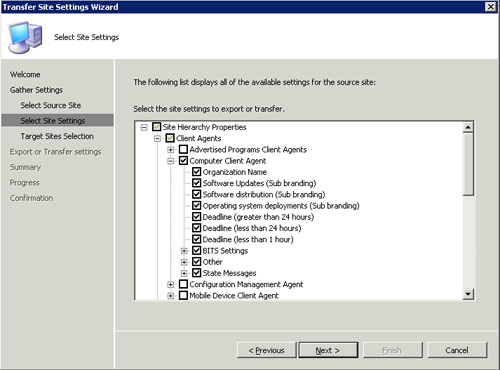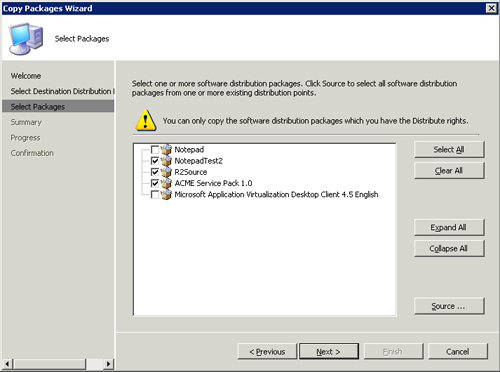1. Transfer Site Settings Wizard
Use the Transfer Site Settings Wizard to transfer
site settings between sites. You can transfer settings down the
hierarchy, or you can export configuration settings to an XML file and
import them to a different site. Perform the following steps:
1. | Right-click
any site in the ConfigMgr Admin console to start the Transfer Site
Settings Wizard. At the Welcome page, click Next to continue.
|
2. | You
have the option to export or import settings. For this example, select
Export settings. Then, on the next screen, select the site to transfer
settings from (the source site).
|
3. | Click Next to select the site settings to transfer (or export), as shown in Figure 1.

|
4. | Select
the destination site(s) or click Next to export the site settings. If
you selected one or more destination sites, the wizard will
automatically begin applying the site settings to each site.
|
5. | A success dialog box will appear upon completion.
|
Caution: Verify Settings for Transfer Site Settings Wizard
The Transfer Site Settings Wizard will do
exactly what you tell it to do—so if you tell it to transfer discovery
methods and include Active Directory containers, you may begin
discovering duplicate objects from different sites, thus causing
additional backlog and confusion at your central site.
If you chose to export the settings to an XML file, you can later import those settings to any site.
2. Copy Packages Wizard
The
Copy Packages Wizard allows you to easily add multiple packages to a
distribution point. You can copy four different types of packages, each
requiring that you initiate the wizard from a different location:
The Packages node, under Software Distribution
The Deployment Packages node, under Software Updates
The Boot Images node, under Operating System Deployment
The Driver Packages node, under Operating System Deployment
Right-click any of the nodes listed here and then select Copy Packages. In the Copy Packages Wizard displayed in Figure 2,
select the destination distribution point. The next page of the wizard
allows you to select multiple packages. You can also click the Source
button to select an existing distribution point. This allows you to
easily select all packages for the new distribution point that are on
the source distribution point.

The process begins when you complete the wizard.
This process uses the same process as if you manually added distribution
points, so monitor the distribution status for each package selected,
if desired.